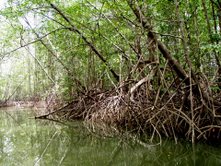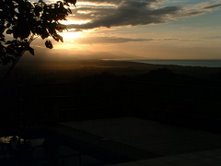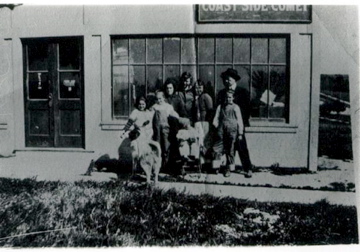2
FAIR HALFMOON BAY.
A Pretty Suburb That
Opposes the Boule
vard.
IT IS NOT IN ITS INTEREST
The People Want a Coast Rail
road Down to Santa
Cruz.
VIEWS OF LEADING CITIZENS.
The Silurians of San Mateo Counted
Upon to Fight Against
Bonding.
HALFMOON BAY, Cat.., April 22.— The
people of Halfmoon Bay and all along the
coast line of San Mateo County are a solid
phalanx in opposition to the boulevard
proposed to be built on the east side of the
county. One of the oldest residents, a
gentleman who has been thirty-live years
in Halfmoon Bay, said to a Call represen
tive in substance: “The boulevard ques
tion now agitating the county if carried
through would be a great detriment to us
all, and especially to the coast side. It
would be morally wrong and totally unfair
to tax the western portion for a road which
would not run within fifteen miles of us.
Why ? For the simple reason that it would
naturally divert and draw all the traffic to
the San Mateo side, and would not benefit
Halfmoon Bay or Pescadero in the least.
The west side has been fighting for years
to get a coast railroad which should go
right along by the ocean down to Santa
Cruz, and eventually join the Santa Fe
system. There are five districts in San
Mateo, with five Supervisors, the First
District of which is the center, Colma, Su
pervisor Jacob Bryan; the Second, San
Mateo. Supervisor Brown ; the Third Dis
trict, IRedwood City, Supervisor P. H. Mc-
Kvoy ; the Fourth District, Halfmoon Bay,
Supervisor Peter Burke ; and the Fifth
District, Pescadero, Supervisor H. B.
Adair.
If the county were bonded for a boule
vard the scheme would have to be put to a
vote of the people, and would include
every bit of taxable property in the county
to pay the bonds. To carry out the scheme
the proposition would have to be carried
by a two-thirds vote. Three-quarters of
the property is on the east side of the
mountains, and on the coast side there are
not enough voters to make even a decent
kick. But the hope of the coast side lies
in the knowledge that in the interior there
A GLIMPSE OF THE TOWN.
are a great many Silurians who would vote
against the boulevard if it did not run
through their property, and benefit them
pecuniarily. So the only thing to squelch
the proposition is to let the property
owners on the other side of the county
beat themselves.
Mr. Ferdinand Levy thought that it
would be manifestly unjust to tax any of
the citizens for a road that would be a detri
ment to them, He also remarked that when
the ocean side wanted to run a coast rail
road the opposite bide of the county re
ceived the scheme with arctic frigidity,
and that it was only natural that the coast
people should oppose a plan which would
cost them money and hurt them if carried
through.
Frank H. Owen, proprietor of the
Coast Advocate, a paper entirely devoted
to the interests of the county, said regard
ing the meeting recently held at Redwood
City: “It was held to talk up a proposi
tion to bond the county for funds with
which to build a boulevard from San Fran
cisco to the south line of San Matto
County. It was conceded at this meeting,
as it is by all who have given the matter
any thought, that bonding the county is
the only way to obtain the necessary
funds.” He doubted, however, whether
the people would vote the bonds. Oppo
sition from the coast side was both feared
and expected and it would be very decided
unless the scheme embraced a good road
from San Mateo to Pescadero. Without
that every one would object to the building
of a road along the bay. The coast wanted
roads as much as any other section of the
county and demanded that its needs be
considered in connection with those of the
bay side.
The present highway was a disgrace and
was good only when the weather was good.
A smooth road was demanded from which
tourists and visitors could enjoy the ex
quisite mountain scenery between San Ma
teo and Halfmoon Bay and the delightful
journey to Pescadero, eighteen miles fur
ther on. If the whole county was to be
taxed, the whole county should receive the
benefit of the project. It will be seen,
therefore, that Mr. Owen is as practical as
he is progressive. He only wants fair play,
and would be glad to see a boulevard con
structed as long as the coast was not left
out in the cold. A road was wanted over
which every draught horse could haul a
ton winter or summer. It would not cost
more than the county could afford and
would pay for itself in actual cash, to say
nothing of satisfaction, within three or
four years.
It will be seen, therefore, that just at
present San Mateo County is a house
slightly divided against itself, but it would
seem only just that if it be bonded to make
a boulevard the coast line, if equally taxed,
should be equally benefited.
There are thousands of San Franciscans
and Californians generally who have lived
here for over a score of years and who
think they know all about the natural
beauties and the glorious scenery of the
State. Yet not one of them, perhaps, ever
rode over the mountains from San Mateo
to Halfmoon Bay. To describe the ex
quisite beauty of the hills, gorges and
canyons would require the pen of a Pius-
I kin or the imagery of an Emerson. The
entire drive is simply a succession of pano
iramas. so varied and yet so beautiful as to
make the best descriptive writer pause be-
fore attempting to sketch them. There
are hills which are almost perpendicular
in their ascent; gulches, hundreds of feet
deep, in which giant redwood trees mingle
with the great white flowers of the dog
wood, the crimson of the red currant, the
creamy tints of the ironwood and all the
other glories of a virgin forest growth.
The variety of timber is almost endless,
the foliage a dream of color and the air as
pure and balmy as the breath of a babe.
In ascending, the hills rise above the visi
tor like majestic giants robed in perennial
verdure. From the summit the visitor
gazes down into richly cultivated valleys,
fields of grain and tiny brooks of silvered
water. The tourist is only twenty miles,
as the crow flies, from San Francisco, yet
he is in a miniature Switzerland minus the
ice and snow.
The ride from San Mateo to Halfmoon
Bay is just thirteen and seven-eighths
miles in length, and every foot of it fur
nishes a scenic feast for the lover of
nature. For a considerable part of the
route the visitor drives by the series of
Crystal Springs Lakes, eleven miles in
length, and at one place crosses them.
The huge dam, 110 feet high, which con
tines the waters of the reservoir, is 60 feet
thick at the base and 10 feet wide on the
summit. The waters average a depth of
ninety feet in the middle and are the
home of the game trout and the equally
plucky black bass.
Spanishtown, or Halfmoon .Bay, was orig
inally settled about forty-five years ago,
mostly by Spaniards, as its old name im
plies. It has two churches, both liberally
supported, the one a Methodist organiza
tion and the other Roman Catholic,
known as “Nuestra Senora de Pilar.”
There are lodges of the Independent Order
of Odd Fellows, the Freemasons, United
Ancient Order of Druids. Ancient Order of
United Workmen and Native Sons. The
leading hotel is the Seaside, kept by Mrs.
S. Cerrero and her husband, who is a chef
de cuisine of rare ability. Another hotel,
“The Occidental,” will shortly be opened
and is now being furnished for the recep
tion of guests.
Halfmoon Bay is a charming summer
resort, for it affords amusement of all kinds.
The ocean yields every species of fish to be
found in the San Francisco markets, and
within four miles there is excellent moun
tain trout-fishing. The visitor can get sal
mon trout without leaving the city, and
game of all kinds is abundant in the hills.
Then comes th« beach drive of nearly
PICTURESQUE CHIMNEY BOOK.
seven miles with bathing that is equal to
the best dips in Monterey, Coronado or
Santa Cruz surfs.
Half moon Bay never having attained
railroad facilities is naturally peopled by
conservative citizens. But though con
servative they are in the main progressive
and full of energy, looking to a boom in
the New California of the future.
Where there are so many solid citizens
in this little community it is difficult to
know of whom to speak first, but the old
est settler is entitled to the honor and he
is to be found in the person of Don Pablo
Vasquez, for forty-seven years a resident of
Half moon Bay, and the son of the foreman
of the Mission Dolores ranch, established
by Junipero Serra long before San Fran
cisco was ushered into existence. He told a
representative of the Call yesterday that
the Franciscan fathers used to run the mis
THE SAN FRANCISCO CALL, TUESDAY, APRIL 23, 1895.
sion cattle on Government land and in tak
ing care of them his father had to live in a
mud house, called in Spanish a casa de
lodo. Asked how these were built he re
plied that first posts were set in the ground
on four corners and willow saplings placed
at close intervals all around. The inter
stices were then filled up with good old
fashioned adobe mud. Layers of tule tied
with rawnide formed the roof, and the
casa de lodo was an accomplished fact.
Don Pablo Vasquez was asked, jokingly, if
he was any relation to the dead bandit of
that surname, and he replied, seriously :
“Yes, he was my first cousin, but I never
saw him in my life.” He has in his pos
session a copy of the Costanso diary of
1769, when Don Gaspar de Portola was Gov
ernor. The original diary is in the Sutro
Library and relates chiefly to the discovery
of San Fiancisco and the settlement of the
Santa Clara Valley. Don Pablo has also
in his possession several very rare and
valuable Spanish documents over 200 years
old.
Festooned with foliage of every kind,
smothered in an indescribable wealth of
roses, and the windows hidden by creepers,
the visitor who pauses on the bridge at
Halfmoon Bay looks down on a deserted
house still in good preservation but utterly
abandoned. It was built years ago on the
bed of the creek which is spanned by the
bridge, and is to-day a picturesque home,
FOUR PROMINENT CITIZENS OF HALFMOON BAY.
although without doors or windows. The
owner was a Mr. Rockefeller, a cousin of
the Standard Oil king, but his home,
almost on the level of the creek, was one
day menaced by a winter flood. As the
waters rose the bank cut away from the
foundations and got behind the house. In
an effort to save the piano the instrument
was raised on wooden trestles four feet
high, but the flood was relentless and ac
complished its work of ruin, leaving the
house a relic of an unwise site, but to-day
standing as primly as ever, environed with
willows, clematis, and an unkempt wealth
of bushes and flowers. Heavy-bearing
fruit trees, now in blossom, surround the
doomed house, and the scene suggests
Goldsmith’s “Deserted Village.”
Halfmoon Bay points with pride to a
good grammar school equipped with five
excellent teacher?. The youth of the com
munity has no right to complain of a lack
of educational facilities. A month ago the
bicycle craze attacked the town, and last
Sunday ten of these machines were cavort
ing madly around the streets with more to
hear from in the near future.
There is no end to the deposit of lime
stone near Halfmoon Bay and petroleum
and bituminous rock are only waiting a
railroad to make their existence felt most
profitably. There are timber, endless
masses of granite, tanbark and other crude
staples all waiting for the coast railroad.
North of Halfmoon Bay is essentially a
vegetable country, although adapted to
various kinds of agricultural products and
dairying. Handicapped as the farmers are
with the necessity of hauling their crops
by team over the heavy mountain grades,
the section north of San Pedro Mountain
has shipped 17,000,000 pounds of cabbage
to the Chicago market and sold nearly as
much in San Francisco in a single season,
besides enormous quantities of green peas,
beans and root crops, for the growth of
which the soil and climate are particularly
adapted. As to milk, butter and small
fruits the supply is practically inex
haustible in a district where the grass is
green for nine months in the year and in
which four crops can be raised every
twelve months. A curious relic of early
days is an adobe house built in 1800 by con
tract by Francisco Barriesa.
Among the prominent merchants is
Ferdinand Levy of Levy Bros., who has
lived here for twenty-three years and con
ducts a store for general merchandise, be
sides owning a large warehouse full of agri
cultural implements. He is always ready
to push the interests of Half moon Bay and
is especially interested in the success of the
proposed coast railroad. In addition to
the other interests of the firm Levy Bros,
carry the agencies of four first-class insur
ance companies.
But if there is one industry more than
another of which Half moon Bay is proud
it is its Creamery. The local paper says in
its issue of April 10: “The new Sharpless
cream separator has been set up in the
creamery and works beautifully. Its
capacity is 2500 pounds an hour. The
creamery is making considerable cheese
now and will while the price of butter is so
low, the output being about 300 pounds per
day. Last month the creamery bought
over 400,000 pounds of milk and the value
of the products was about $1500.
Another prominent industry is that of
R. T. Knapp, who is the patentee and
manufacturer of a side-hill plow, so neces
sary in the mountains. It is used for land
breaking, vineyard, orchard and general
farming work. Mr. Knapp established
water works in 1885 and enlarged his sys
tem this year. He has a reservoir holding
1,000,000 gallons three miles from town and
distributes water all over through 10-inch
mains. It. is fine spring water. The gen
tleman is a strong temperance man and has
erected a drinking fountain for general use
and presented it to the town.
THE MOBS BEACH HOUSE.
Seven miles from Halfmoon Bay on the
beach and the road to Colma, in the town
ship known as the ”Colony,” there is a
lovely resort known as the Moss Beach
House, where good bathing can be en
joyed, and sea moss, abalones, shells and
curios can be collected and gathered ad
libitum. The location is one of extreme
loveliness, and the resort is owned by a
most progressive German, J. F. Wienke.
Cottages surround the house and stages
connect it with Colma.
The legal and judicial interests of Half
moon are represented by Mr. John Pitcher,
Justice of the Peace, a pleasant and uni
versally respected gentleman.
The oldest settlor in the community,
without counting Mr. Vasquez, who was
born here, is William Pringle, who has a
harness-shop and thinks there is nothing
like leather.
It would require too much space to de
scribe the beauties of Purissimo Falls,
Chimney Rock, Seal Rock and other points
of interest; but it would be unfair to close
this article without a good word for the
Coast Advocate, the paper which is all in
all to Halfmoon Bay.
The editor, Frank H. Owen, is a native
of Oregon, and has been in the newspaper
business from his early boyhood. At four
teen years of age he was apprenticed as a
printer, and six months after serving his
four years’ “time” became a newspaper
editor and publisher, by reason of his em
ployer failing to pay the wages he had
earned. The voting man was compelled to
take the paper in settlement of the debt.
Later Mr. Owen came to California and,
after marrying, returned to Oregon, where
for a number of years he was foreman of
the daily Evening Telegram of Portland.
Getting tired of working for wages, and
believing his talent as a writer would yield
a better income than that paid a printer,
he went over to Washington, then a Terri
tory, and bought the Chehalis Bee, and
soon made it the leading country newspa
per of Western Washington.
After engaging in several other success
ful newspaper enterprises, Mr. Owen em
barked in land speculation at a time when
all Oregon and Washington was wild over
boom townships, and, as might have been
expected, lost the money he had made
while engaged in the business he was
familiar with. He then came to California
aeain, traveled the State all over, decided
that while this was the garden of the
world, San Mateo was the gem of the gar
den, and there he has his home. Mr. Owen
is a stanch Republican and something of
a politician. If he has a hobby it is that
of county roads, and believes that the
building of first-class turnpike roads are
only second in importance in the develop
ment of a country to railroads. He is
heartily in accord with the Call on its
boulevard proposition, providing that the
scheme is broad enough to build a coast
turnpike at the same time. While his
newspaper, the Coast Advocate, is not a
large one, it is all home print and always
filled with original matter, a feature of
which is articles descriptive of the attrac
tions and resources of the county. He has
an accomplished wife, who ia also a writer
of considerable ability.








